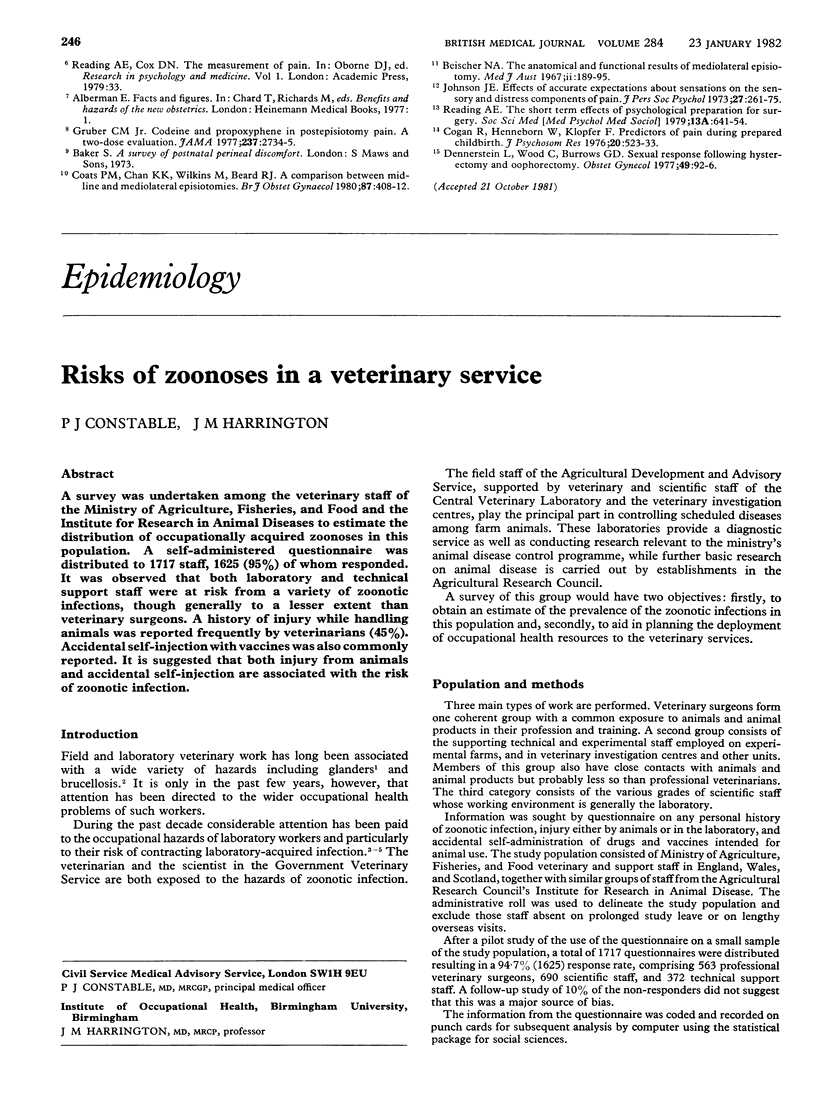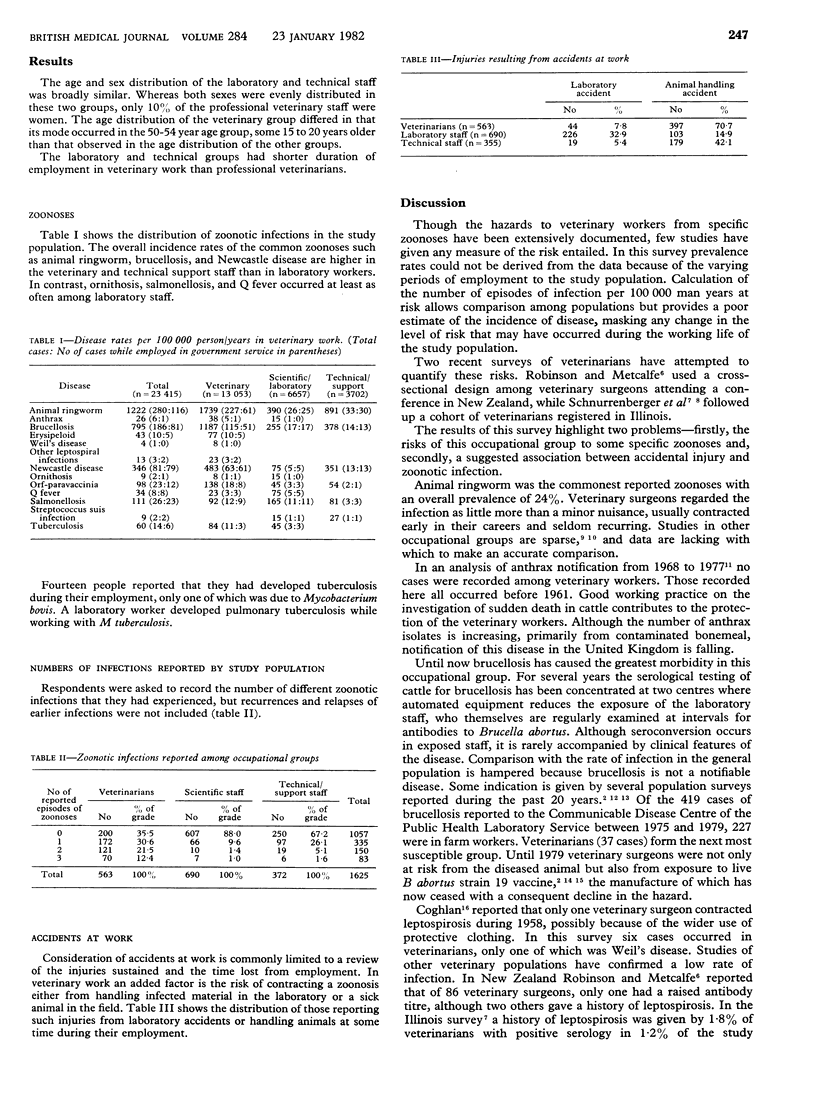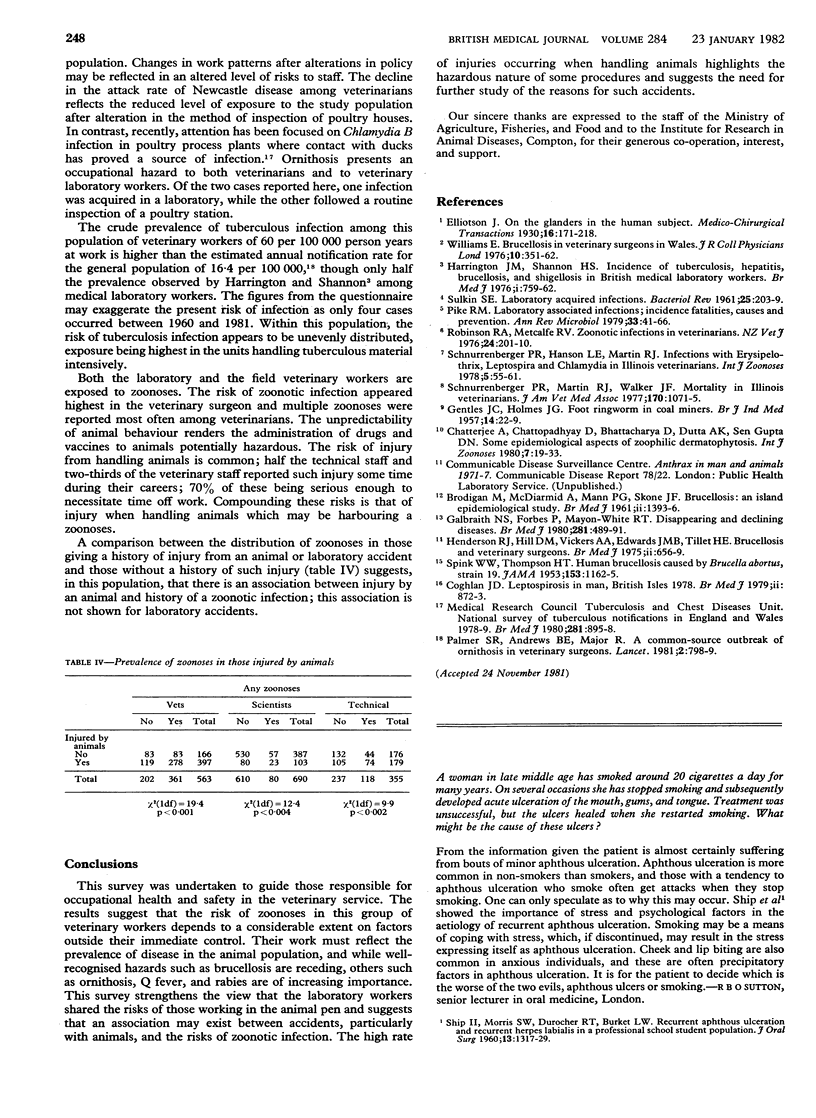Abstract
A survey was undertaken among the veterinary staff of the Ministry of Agriculture, Fisheries, and Food and the Institute for Research in Animal Diseases to estimate the distribution of occupationally acquired zoonoses in this population. A self-administered questionnaire was distributed to 1717 staff, 1625 (95%) of whom responded. It was observed that both laboratory and technical support staff were at risk from a variety of zoonotic infections, though generally to a lesser extent than veterinary surgeons. A history of injury while handling animals was reported frequently by veterinarians (45%). Accidental self-injection with vaccines was also commonly reported. It is suggested that both injury from animals and accidental self-injection are associated with the risk of zoonotic infection.
Full text
PDF


Selected References
These references are in PubMed. This may not be the complete list of references from this article.
- BRODIGAN M., McDIARMID A., MANN P. G., SKONE J. F. Brucellosis--an island epidemiological study. Br Med J. 1961 Nov 25;2(5264):1393–1396. doi: 10.1136/bmj.2.5264.1393. [DOI] [PMC free article] [PubMed] [Google Scholar]
- Chatterjee A., Chattopadhyay D., Bhattacharya D., Dutta A. K., Sen Gupta D. N. Some epidemiological aspects of zoophilic dermatophytosis. Int J Zoonoses. 1980 Jun;7(1):19–33. [PubMed] [Google Scholar]
- GENTLES J. C., HOLMES J. G. Foot ringworm in coal-miners. Br J Ind Med. 1957 Jan;14(1):22–29. doi: 10.1136/oem.14.1.22. [DOI] [PMC free article] [PubMed] [Google Scholar]
- Galbraith N. S., Forbes P., Mayon-White R. T. Changing patterns of communicable disease in England and Wales: part II-Disappearing and declining diseases. Br Med J. 1980 Aug 16;281(6238):489–492. doi: 10.1136/bmj.281.6238.489. [DOI] [PMC free article] [PubMed] [Google Scholar]
- Harrington J. M., Shannon H. S. Incidence of tuberculosis, hepatitis, brucellosis, and shigellosis in British medical laboratory workers. Br Med J. 1976 Mar 27;1(6012):759–762. doi: 10.1136/bmj.1.6012.759. [DOI] [PMC free article] [PubMed] [Google Scholar]
- Henderson R. J., Hill D. M., Vickers A. A., Edwards J. M., Tillett H. E. Brucellosis and veterinary surgeons. Br Med J. 1975 Jun 21;2(5972):656–659. doi: 10.1136/bmj.2.5972.656. [DOI] [PMC free article] [PubMed] [Google Scholar]
- Palmer S. R., Andrews B. E., Major R. A common-source outbreaks of ornithosis in veterinary surgeons. Lancet. 1981 Oct 10;2(8250):798–799. doi: 10.1016/s0140-6736(81)90199-9. [DOI] [PubMed] [Google Scholar]
- Pike R. M. Laboratory-associated infections: incidence, fatalities, causes, and prevention. Annu Rev Microbiol. 1979;33:41–66. doi: 10.1146/annurev.mi.33.100179.000353. [DOI] [PubMed] [Google Scholar]
- Robinson R. A., Metcalfe R. V. Zoonotic infections in veterinarians. N Z Vet J. 1976 Sep;24(9):201–210. doi: 10.1080/00480169.1976.34317. [DOI] [PubMed] [Google Scholar]
- SPINK W. W., THOMPSON H. Human brucellosis caused by Brucella abortus, strain 19. J Am Med Assoc. 1953 Nov 28;153(13):1162–1165. doi: 10.1001/jama.1953.02940300020006. [DOI] [PubMed] [Google Scholar]
- SULKIN S. E. Laboratory-acquired infections. Bacteriol Rev. 1961 Sep;25:203–209. doi: 10.1128/br.25.3.203-209.1961. [DOI] [PMC free article] [PubMed] [Google Scholar]
- Schnurrenberger P. R., Hanson L. E., Martin R. J. Infections with Erysipelothrix, Leptospira, and Chlamydia in Illinois veterinarians. Int J Zoonoses. 1978 Jun;5(1):55–61. [PubMed] [Google Scholar]
- Williams E. Brucellosis in veterinary surgeons in Wales. J R Coll Physicians Lond. 1976 Jul;10(4):351–362. [PMC free article] [PubMed] [Google Scholar]


